Guangzhou Evergrande Football Stadium
| Capacity | 100 000 |
|---|---|
| Country | People's Republic of China |
| City | Guangzhou |
| Clubs | Guangzhou Evergrande FC |
| Category | Design outdated |
| Cost | CNY 4.3 B ($610 M) |
| Construction | 2020–2022 |
| Design | Gensler |
| Contractor | China Construction Fourth Engineering Bureau |
Advertisement
Guangzhou Evergrande Football Stadium – design description
What is the story behind the world's largest football stadium, which was to be built in Guangzhou?
In the second decade of the 21st century, Guangzhou Evergrande FC, a football club from Guangzhou, a huge city (and even bigger agglomeration) in southern China, backed by real estate giant Evergrande Group, was enjoying a series of extraordinary sporting successes and was popular with fans.
Thanks to the opportunities Evergrande Group had, there were plans to build a new stadium for the team. It would be no ordinary stadium, as with a capacity of 100,000 spectators it would become the largest (football-specific) stadium in the world, at least until Camp Nou was expanded.
Construction began in 2020 and initially went very smoothly, but in the process Evergrande Group got into huge financial trouble and was unable to continue to maintain the club or pay for the construction of the stadium. Work was halted, and a company controlled by the city took over the project.
It was decided to finish the construction, but now according to a completely different design. Capacity was reduced to 73,000 spectators, which is still supposed to make the stadium the largest – at least in China alone.
The huge stadium actually had two concepts. According to the first, it was to look like a blooming lotus flower. While this was a very impressive vision, it also stirred up quite a bit of controversy, so it was eventually abandoned and a second, more subdued one was adopted for implementation, according to which the stadium was to resemble both a flower and a diamond.
The concept, due to its scale and offbeat style (especially in the original version), attracted worldwide interest. If realized in the proposed form, the stadium would have a chance to become not only a globally recognized sports venue, but also a distinctive symbol of the city.
What, in detail, is the story behind the plans to build a new stadium for Guangzhou Evergrande FC?
For whom was a new football stadium to be built in Guangzhou?
In 2010, development tycoon Evergrande Group took over the Guangzhou FC team (which was consequently renamed Guangzhou Evergrande FC). Evergrande invested serious funds in the club, and the team quickly became a domestic hegemon that also counted on the international stage.
In the 2010 season, the team was promoted to the Chinese Super League, and then from 2011 to 2017 scored a series of seven consecutive championship titles. In the following years the team continued to stay off the league podium, winning one more championship in 2019. The club was also successful in other competitions, including the Asian Champions League, which it won twice (2013, 2015).
Ever since Evergrande took over the club, there had already been thoughts of building a new stadium for the team. With continued successes and given the high attendances at Tianhe Stadium, these plans seemed to have a solid foundation. Ideas of rebuilding Tianhe Stadium and Yuexiushan Stadium, as well as building an entirely new stadium together with another top-level Guangzhou team, Guangzhou R&F, were in discussion.
Where was a new stadium to be built for Guangzhou Evergrande FC?
In 2016, local authorities approved a plan that allowed for the construction of a large soccer stadium near the new Guangzhou South railroad station. In 2018, it was reported in the media that a new stadium for Guangzhou Evergrande FC was to be built there.
Although there was only speculation circulating about it, Evergrande was indeed planning to build a new stadium at the site and held a closed competition for the architectural concept, to which studios from around the world were invited.
The plot of land on which the new stadium was envisioned is located in Panyu district, about 2.5 kilometers east of Guangzhou South railway station. The station opened in 2010 and was the largest railroad station in Asia at the time of its commissioning. It is expected to serve as the main transportation hub for the entire metropolitan area.
The site chosen for the stadium is quite far from downtown Guangzhou (about 20 kilometers to the south). However, the choice of this site offers the opportunity to create a facility that would serve as a leading, representative football stadium for the entire Pearl River Delta Metropolitan Region.
When did the project to build a new stadium for Guangzhou Evergrande FC begin?
In March 2020, a tender was issued for the sale of a plot of land near Guangzhou South station. The specifications stated that a football stadium with a capacity of at least 80,000 spectators should be built on it, which, of course, greatly narrowed the pool of potential interested parties.
On April 16, 2020, a tender for the sale of the plot was settled, which was won by Evergrande as the only interested party. Since it was obvious who would win the proceedings, preparations had already been made for the occasion, and a groundbreaking ceremony took place on the same day (despite the fact that the deal with the contractor had not yet been signed at the time).
Although the whole tender seemed to be prepared for Evergrande, the developer had to pay a considerable price (6.81 billion yuan) for the plot. In early May 2020, a deal was signed with the main contractor, China Construction Fourth Engineering Bureau, and the construction contract was worth 4.3 billion yuan. All of Evergrande's expenditures related to this investment were to exceed 12 billion yuan. According to the plan, the stadium was to be ready by the end of 2022.
When was the concept for a new stadium for Guangzhou Evergrande FC presented?
When the result of the tender for the purchase of the land was announced in April 2020, Evergrande also presented the architectural concept for the new stadium. The author of the project, which was selected through a competition, was the American studio Gensler, led by Hasan Syed. According to the design, the stadium was to look like a blooming lotus flower. The concept was grandiose, but it drew mixed feelings from critics.
When were the original plans for a new stadium for Guangzhou Evergrande FC changed?
After the concept was presented, consultations were held, which resulted in the decision to change the design. On July 3, 2020, a new variant was approved for implementation, according to which the stadium was to resemble not only a flower from the outside, but also a diamond, as a nod to the jewelry industry for which the Panyu district is famous. In the new version, the design continued to impress, although it was no longer as expressive – and controversial at the same time.
How did the construction of the new stadium for Guangzhou Evergrande FC proceed?
Construction of the stadium initially went according to plan. After the foundations were laid in 2020, the lower ring of stands was built in the first half of 2021. In 2021, however, news broke of Evergrande Group's massive problems and debts exceeding $300 billion (these issues later led the company to bankruptcy and liquidation).
Due to Evergrande's problems, construction of the stadium slowed down in mid-2021. The city's Guangzhou City Investment Group took over supervision of the investment. Work was still underway, although no more significant progress was made over the next year. Instead, consultations began with the soccer community and architects about the future of the project, realizing that the scope of the investment would most likely have to be reduced.
On August 3, 2022, an agreement was signed whereby the land, along with the unfinished stadium, was handed back to the local authorities. The indebted Evergrande received 5.52 billion yuan for handing over the land. Construction work has been halted completely.
What is the fate of the new stadium for Guangzhou Evergrande FC after the withdrawal of Evergrande Group?
In September 2022, the city announced a new tender for the sale of the plot. The starting price was set at 3.155 billion yuan (much lower than in 2020, when it was 6.81 billion yuan). The tender was resolved on October 10, 2022, and the buyer (for a base price of 3.155 billion yuan) was Guangzhou City Investment Group, the same company that actually took over management of the project back in 2021.
Guangzhou City Investment Group invited architects to work on optimizing the project, and announced the renaming of the stadium to Guangzhou Football Park (from the previously used name Guangzhou Evergrande Football Stadium).
When was the new stadium design for Guangzhou Evergrande FC unveiled?
On September 6, 2023, the Guangdong Province Architectural Design and Research Institute announced, through its media, the victory of the Guangzhou Football Park design optimization competition. Renderings have also been published and some details of the new concept have been given.
What does the new Guangzhou Football Park design entail?
The architectural concept for Guangzhou Football Park can be seen on a separate subpage
Changes to the design include a reduction in the capacity of the stands to 73,000 spectators (compared to the previously assumed 100,000). The exterior has also been completely transformed: the new design is inspired by the pattern of an ancient dragon and phoenix artifact found in the Nanyue King Mausoleum, as well as the local art of ivory carving.
When will the Guangzhou Football Park be completed?
On March 12, 2024, the China Construction Fourth Engineering Bureau announced that it had won the bid to complete the stadium (the same company started its construction and ran it until it was suspended due to Evergrande's problems). The value of the new contract is 2.356 billion yuan. Work resumed on March 26, 2024, and the stadium should be ready by the end of 2025.
A report on the construction of Guangzhou Football Park can be seen on a separate subpage
What was the Guangzhou Evergrande FC stadium supposed to look like?
The initial vision for a new stadium for Guangzhou Evergrande FC was unveiled on April 16, 2020, the same day that the tender for the purchase of the land for construction was awarded and its construction symbolically began. The author of the project, selected through a closed competition, was the American studio Gensler, led by Hasan Syed.
The stadium was to accommodate 100,000 spectators and, from the outside, look like a blooming lotus flower. The concept had a lot of advantages, but among its many shortcomings it was accused of being kitschy and too distinctive in style. After consultations, a modified, slightly toned-down version of the design was presented on July 3, 2020, which was also meant to reference the local jewelry industry.
What was the first concept for a new stadium for Guangzhou Evergrande FC?
With giant "petals" forming the exterior, the facility was to resemble a lotus flower in bloom, in reference to Guangzhou's nickname as the "city of flowers". The design was impressive in scale and certainly original, but many critics did not like the vision presented.
The stands of the new stadium, divided into three rings, were to hold 100,000 people, making the facility the largest football-specific stadium in the world (at least until the expansion of Camp Nou). Beneath the auditorium, there were to be seven floors and 300,000 sq. ft. of commercial facilities, so that the building would also serve as a huge shopping and entertainment center.
What was the idea behind the second concept of a new stadium for Guangzhou Evergrande?
A modified variant was also prepared by Gensler. According to the new vision, the stadium was to resemble not only a flower from the outside, but also a diamond, referring to the jewelry industry for which the Panyu district is famous.
The diamond form was to be given to the stadium's exterior, with a steel frame forming the roof and facade, finished with a lightweight ETFE membrane, photovoltaic glass and perforated aluminum. A noticeable change in the design compared to the previous version was also the wavy top edge of the stands. The capacity, however, remained unchanged.
Advertisement
Renderings
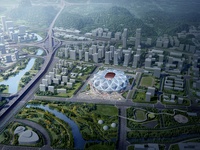
07.2020 © Guangzhou Evergrande 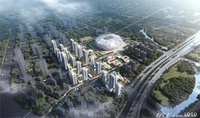
07.2020 © Guangzhou Evergrande 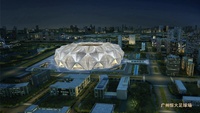
07.2020 © Guangzhou Evergrande 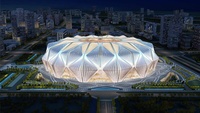
07.2020 © Guangzhou Evergrande 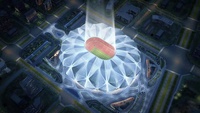
07.2020 © Guangzhou Evergrande 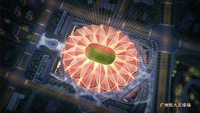
07.2020 © Guangzhou Evergrande 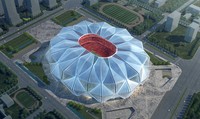
07.2020 © Guangzhou Evergrande 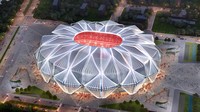
07.2020 © Guangzhou Evergrande 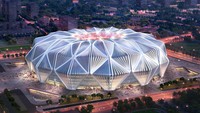
07.2020 © Guangzhou Evergrande 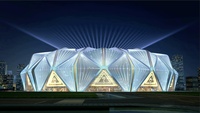
07.2020 © Guangzhou Evergrande 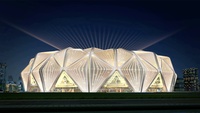
07.2020 © Guangzhou Evergrande 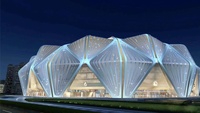
07.2020 © Guangzhou Evergrande 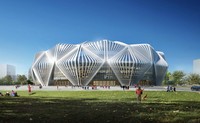
07.2020 © Guangzhou Evergrande 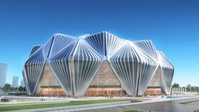
07.2020 © Guangzhou Evergrande 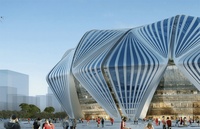
07.2020 © Guangzhou Evergrande 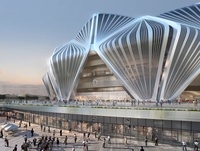
07.2020 © Guangzhou Evergrande 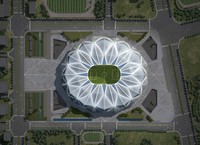
07.2020 © Guangzhou Evergrande 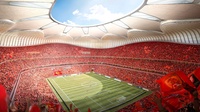
07.2020 © Guangzhou Evergrande 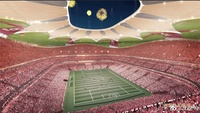
07.2020 © Guangzhou Evergrande 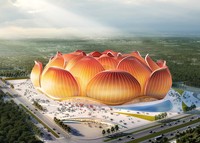
04.2020 © Guangzhou Evergrande 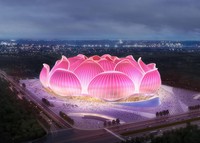
04.2020 © Guangzhou Evergrande 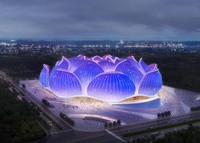
04.2020 © Guangzhou Evergrande 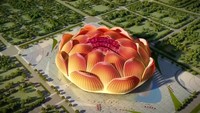
04.2020 © Guangzhou Evergrande 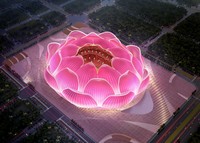
04.2020 © Guangzhou Evergrande 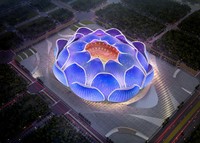
04.2020 © Guangzhou Evergrande 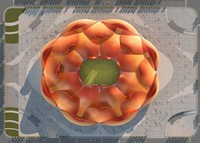
04.2020 © Guangzhou Evergrande 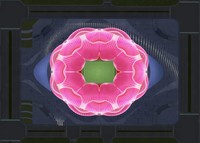
04.2020 © Guangzhou Evergrande 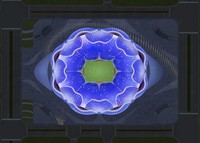
04.2020 © Guangzhou Evergrande 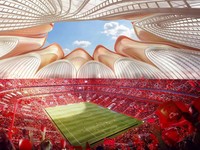
04.2020 © Guangzhou Evergrande 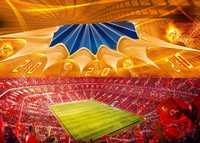
04.2020 © Guangzhou Evergrande
04.2020:
 StadiumDB
StadiumDB